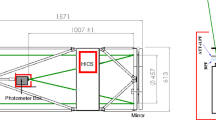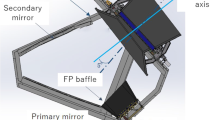Abstract
The effects of changes in the space environment on the ISOPHOT photoconductivedetectors over the whole ISO mission were studied using the complete setof responsivity check measurements taken after the curing of the detectors.We found that the responsivity of the Ge-based, low bias voltage far-infrared detectors (P3, C100, and C200) is sensitive to the conditions of the Space Weather.We present evidence that an increased responsivity level (20% – 50%) after curing of the detectors is linked to the onset of geomagnetic storms. TheSi-based, high bias voltage detectors P1, P2 and PHT–SS show only small changesin their responsivity. An exception is the PHT–SL array which shows a similar,but less pronounced behaviour as the FIR detectors. While these relationshave been demonstrated by our study, a detailed physical understanding is still outstanding. The Space Weather dependent scatter of the responsivity,being the photometric scaling factor (conversion from measured photo currentto inband power on the detector), justifies the observing mode design to include frequent monitoring of its actual level.
Similar content being viewed by others
References
Bartels J.: 1957, The technique of scaling K and Q of geomagnetic activity, Ann. Intern. Geophys. Year 4, p. 215-226.
Chatfield, C.: 1975, The Analysis of the Time Series. London. Chapman and Hall.
Daly J.: 1988, The tEvaluation of Space Radiation Environments for ESA projects, ESA Journal 12, p. 229.
Evans H.D.R.: 1998, Space Radiation Environment during ISO mission, Doc. reference:ESA/ESTEC/EMA/HE/ISO/98-1).
Kessler M.F., Steinz J.A. and Anderegg M.E. et al.: 1996, The Infrared Space Observatory (ISO) mission, Astronomy and Astrophysics 315, L27-L31.
Lemke D., Klaas U. and Abolins J. et. al.: 1996, ISOPHOT--Capabilities and Performance, Astronomy and Astrophysics 315, L64-70.
Lemke D., Garzó n F. and Gemünd H.-P. et al.: 1993, Infrared Spaceborne Remote Sensing, Proc. SPIE 2019, p. 28-33.
Menvielle M. and Berthelier A.: 1991, The K-derived planetary indices: description and availability. Rev. Geophys. 29, p. 415-432.
Schubert J., Roth G., Wolf J. and Lemke D.: 1994, Correction and curing of in-orbit induced nonideal behaviour of ISOPHOT' photodetectors. Proc. SPIE 2268, p. 283-294.
Wolf J.: 1992, Photon Detectors for Space Instrumentation. Proc. ESA, SP-356, p. 137-146.
Author information
Authors and Affiliations
Rights and permissions
About this article
Cite this article
Castañeda, H.O., Klaas, U. Recognition of Space Weather Impact on the Isophot Detectors. Experimental Astronomy 10, 369–380 (2000). https://doi.org/10.1023/A:1008069822196
Issue Date:
DOI: https://doi.org/10.1023/A:1008069822196




